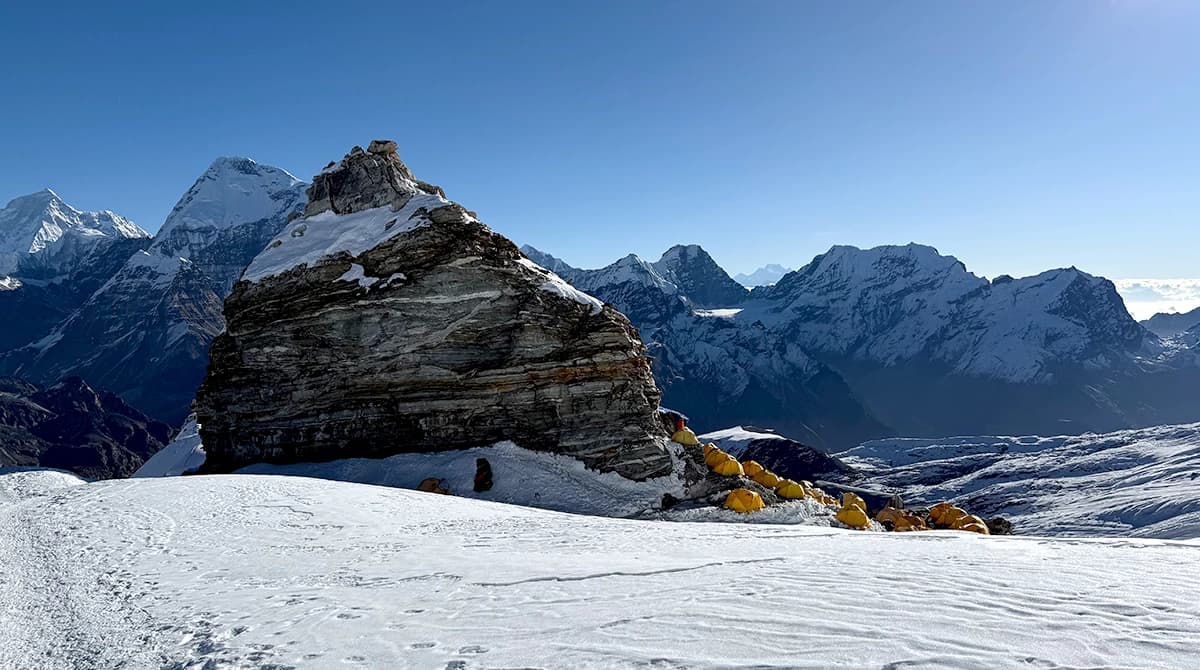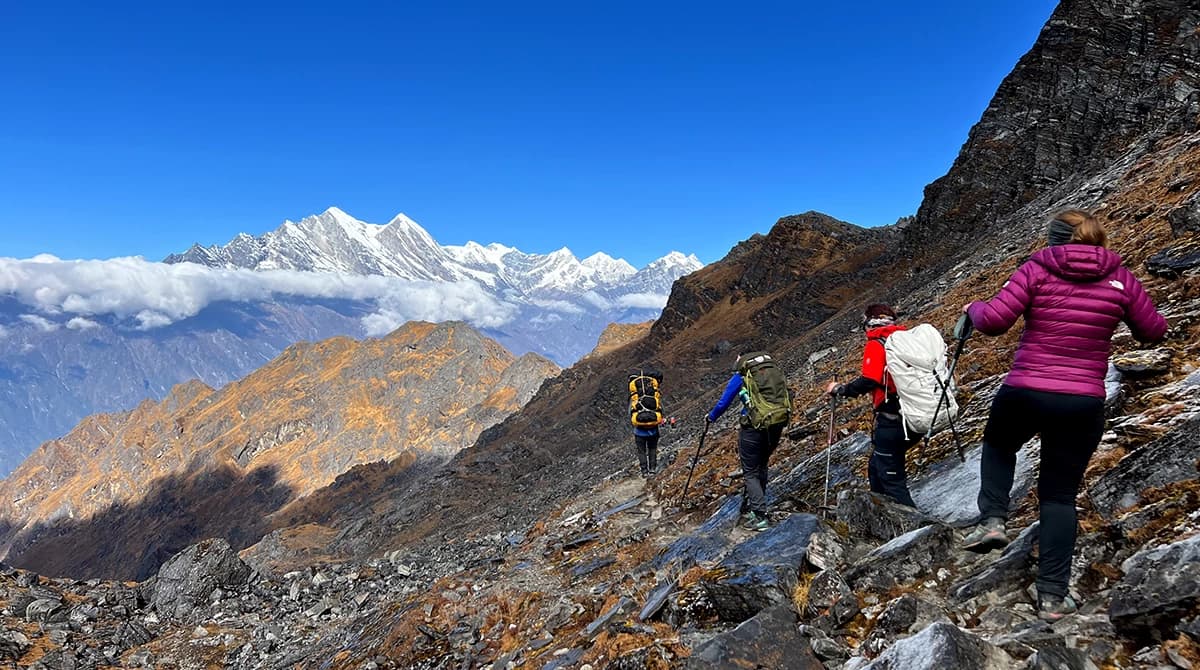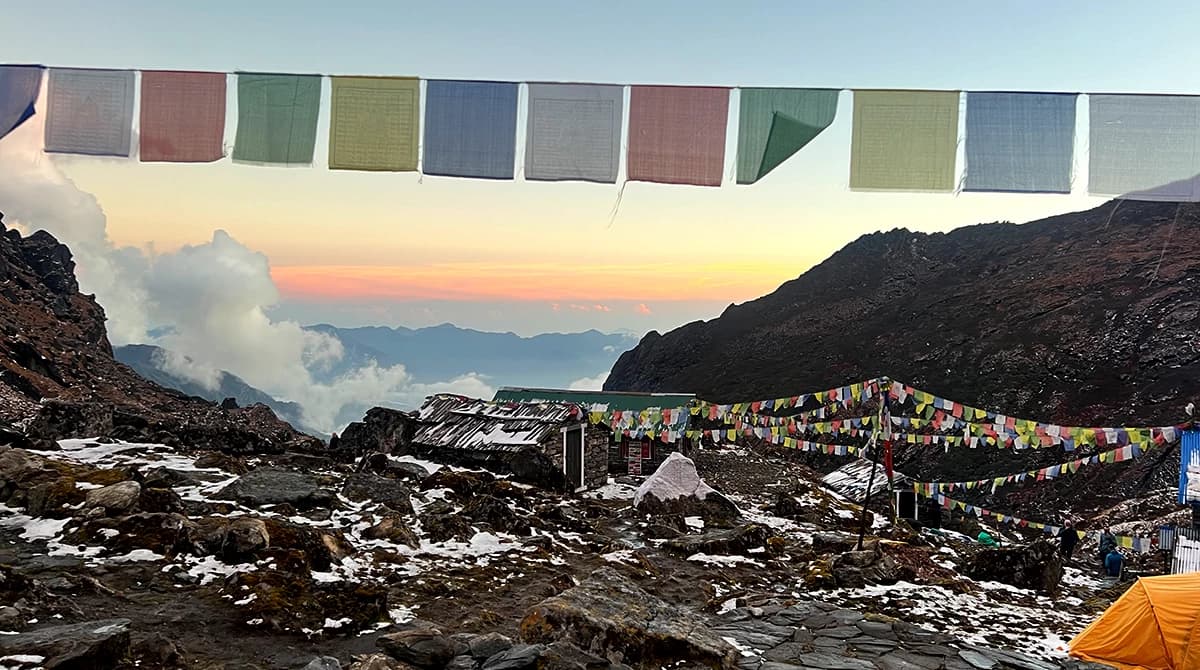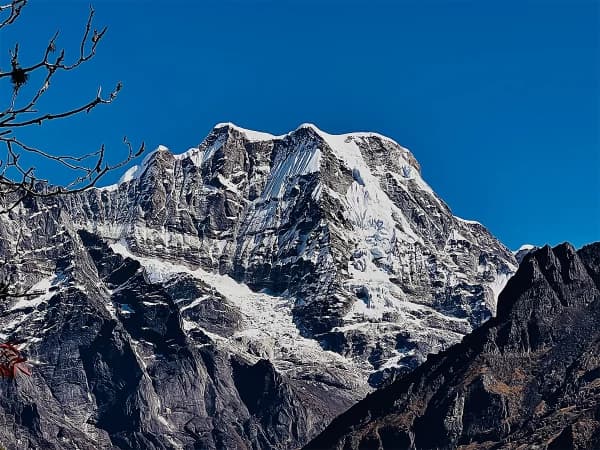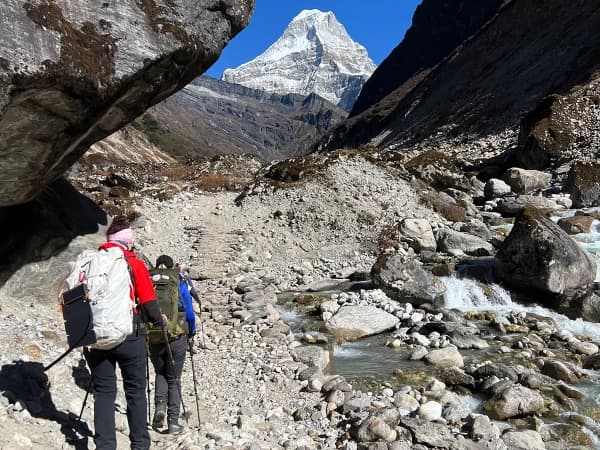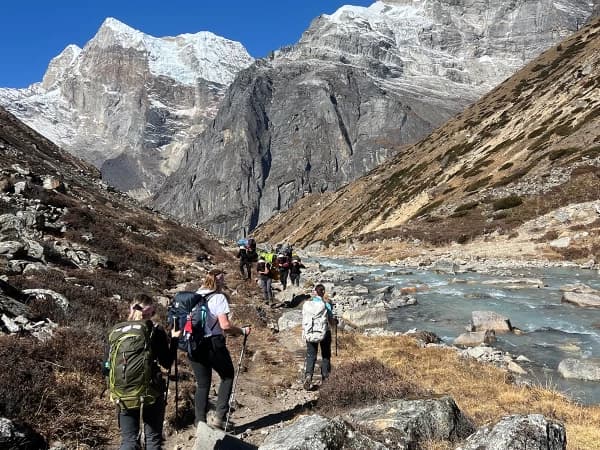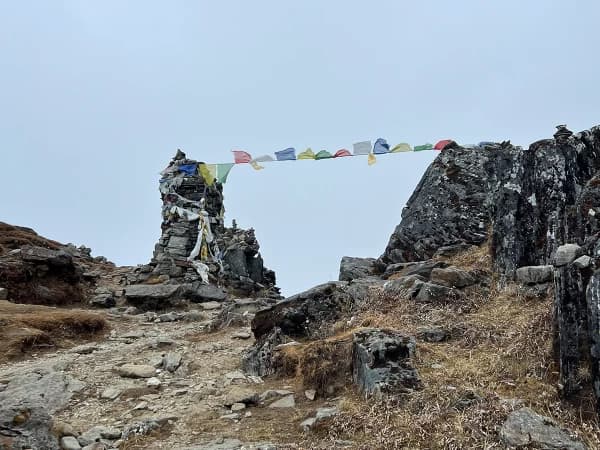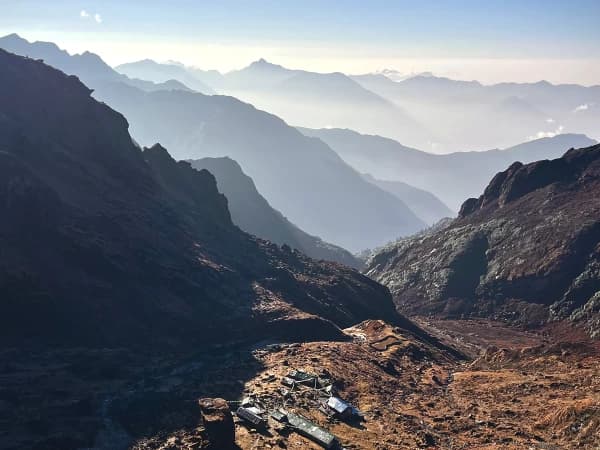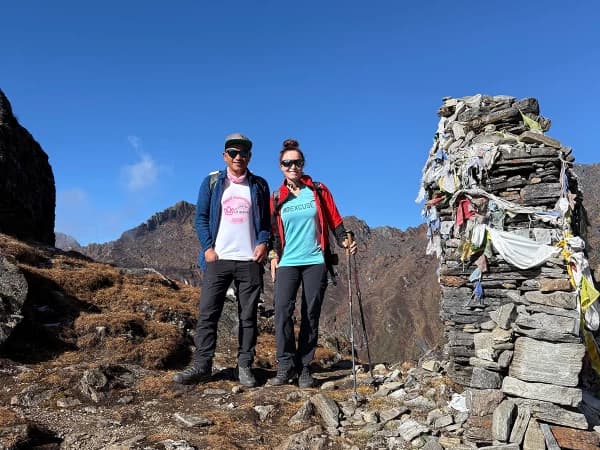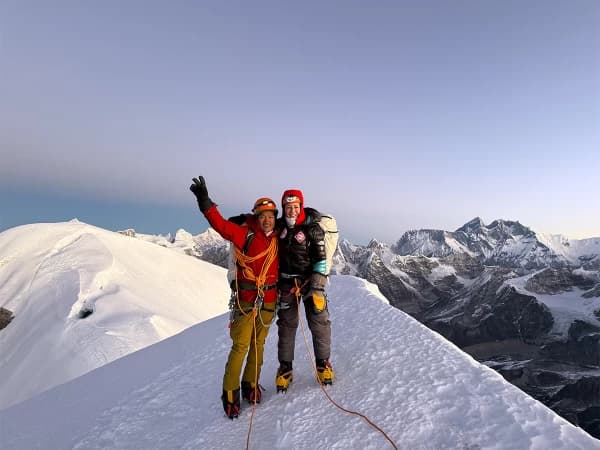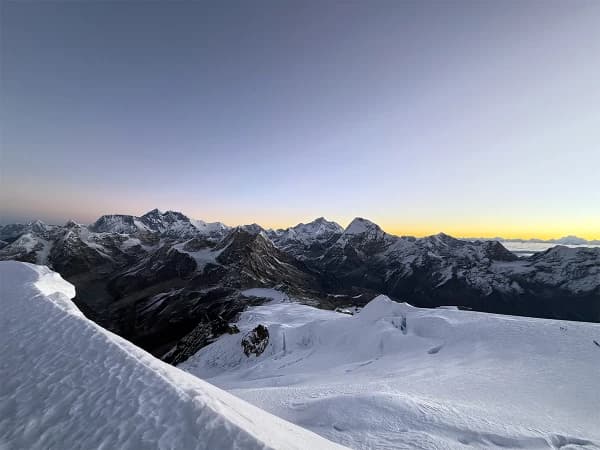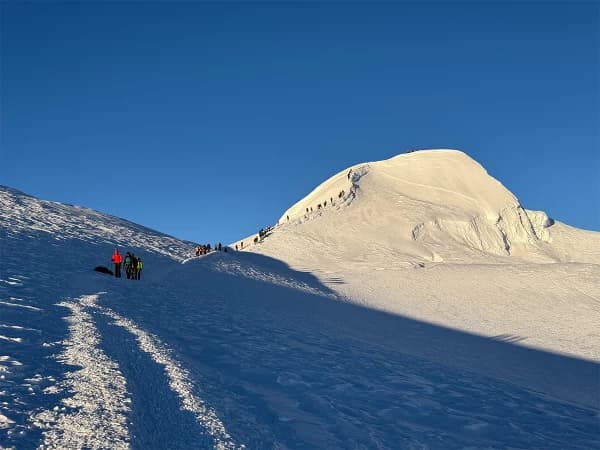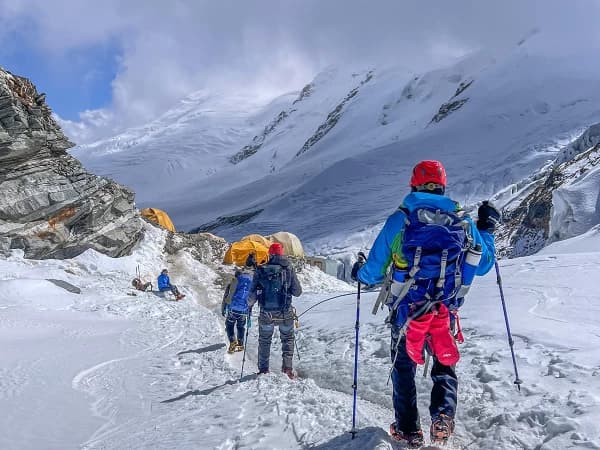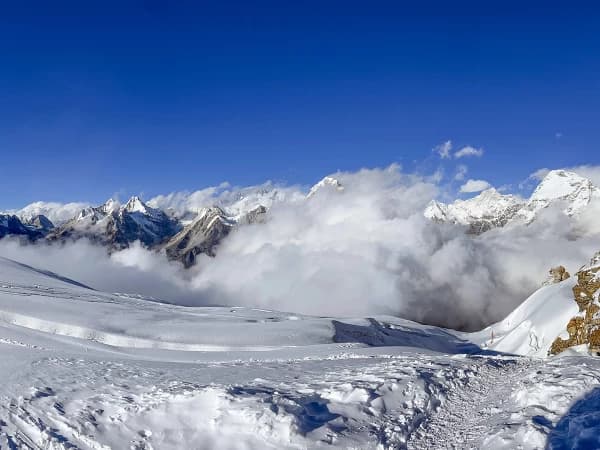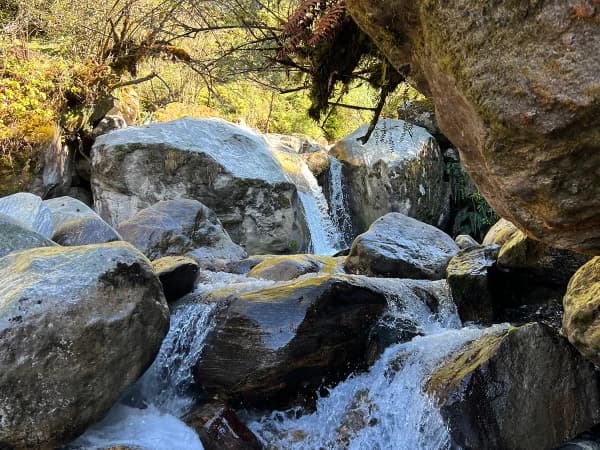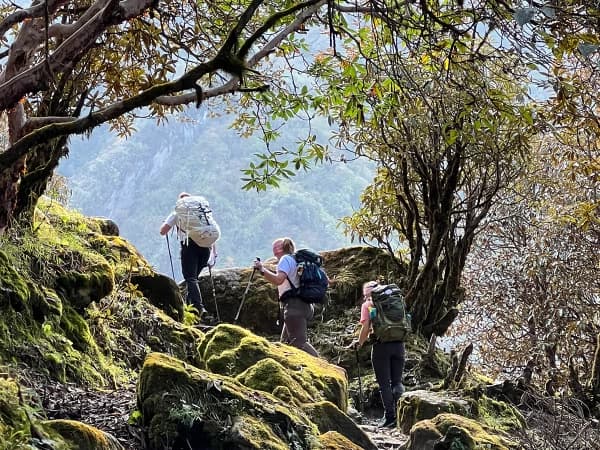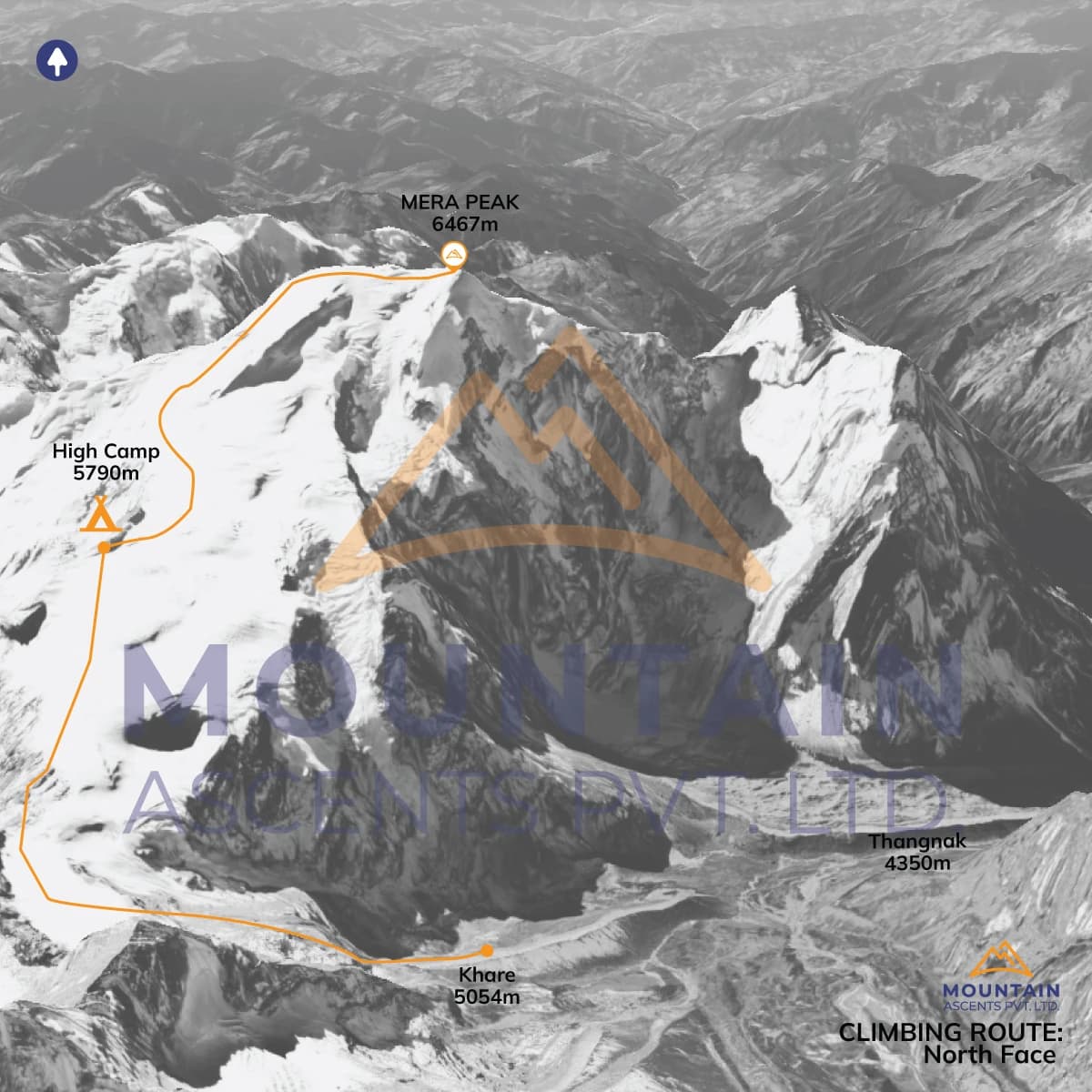The Mera Peak Climbing is an enchanting Himalayan journey to one of Nepal’s highest trekking peaks in the Makalu Barun sub-section of the Himalayas at 6,476 m above sea level. Nestled in the remote Hinku Valley, it is one of the top ten climbing destinations, offering an excellent blend of adventure with top-notch Himalayan views, natural splendor, and the warm hospitality of the Himalayan locals.
The expedition typically involves a scenic mountain flight to Lukla from Kathmandu and a trek through the Khumbu/Everest region of Nepal, which however diverges from the classic Everest Base Camp route, passing by Paiya, Pangom, Nashing Dingma, Chhatra Khola, Kothe, Thagnak, and Khare, ultimately leading to Mera High Camp and the summit peak itself. Throughout the journey, trekkers, climbers, and nature lovers get to make their way through diverse terrains, traditional Sherpa villages, and dense forests of rhododendron and pine.
As you move further into the Himalayas for the Mera Peak Climbing, you will be stunned by the breathtaking panoramic views of the snow-capped peaks set like bright smiling teeth, added much to the thrill by high suspension bridges over roaring rivers and serene landscapes, keeping you refreshed and energetic almost all the time. As you reach the top of Mera Peak, featuring three prominent summits: Mera North, Mera South, and Mera Center, it rewards you with the majestic view of five of the world's tallest mountains, including Mt. Everest, Mt. Kanchenjunga, Lhotse, Makalu, and Cho Oyu.
The climb to Mera Peak at first began in 1953 with Col. Jimmy Roberts and his team, and in 1975, a French team ascended Mera North. Expect traversing through high-altitude glaciers, snowfields, and rocky terrain that is still relatively easy to climb and convenient even for climbers with basic mountaineering skills and a strong will to achieve, despite its intimidating reputation. For a summit attempt that is both safe and successful, however, sufficient acclimatization and physical fitness are absolutely necessary.
Therefore, for those seeking the ultimate mountain ascent experience, the Mera Peak guarantees an incredible adventure through some of the world's most breathtaking scenery that comes with an unparalleled sense of achievement, serenity, and cultural immersion led by the experienced climber Prem Magar, who will provide you with expert advice from Mountain Ascents.
Trip Highlights
- Venture around the well-known capital city of Nepal, Kathmandu, for its at least seven UNESCO World Heritage Sites.
- An adrenaline-rushing aerial journey to one of the world’s highest airports, Lukla.
- Experience the best of both the Khumbu and Hinku Valleys of the Everest region of Nepal, protected under the natural heritage site of Nepal, the Sagarmatha National Park.
- Amazing insight into the remote lifestyle highly influenced by Tibetan and Buddhist culture in the Himalayas of Nepal as you traverse through tiny yet scenic Himalayan settlements, verdant valleys, and different climatic zones, gradually ascending to the magnificent summit of Mera at 6,476 m.
- A golden chance to witness five of the highest peaks on the earth from one single Mera Peak, such as Makalu, Kanchenjunga, Cho Oyu, and Lhotse, including the largest mountain peak on the earth, Mt. Everest (8,848 m).
- Mark your victory at the highest trekking peak of Nepal, Mera Peak.
- Let yourself be free in the serene natural beauty of the Himalayas, featuring lush forests of rhododendron, pine, fir, and oak in the lower region and alpine meadows in the higher altitude.
- The rewarding experience of making way through one of the high mountain passes, Zatra wa la Pass (4,600 m), shimmering glacial rivers, cascading waterfalls, pasturelands, spectacular Himalayan views, and many more.
What makes the Mera Climbing Expedition special?
During the 19-day trip to Mera Peak, one must be well prepared for the high altitude and low level of oxygen as you move closer and closer to the final destination. Throughout the route, you will be impressed with diverse climates, vegetation, wildlife, and charming villages, added much by the warm hospitality of Himalayan locals predominated by Sherpas sharing close cultural ties with Tibetans and Tibetan Buddhism.
The journey is as exhilarating as it can get, which also involves pre-climbing training and essential equipment along with trekking through remote valleys, acclimatization, and paving the way through the highly elevated Himalayas, promising a once-in-a-lifetime experience. Join us for this exceptionally special experience for several reasons, some as highlighted below within the Sagarmatha National Park, standing at the edge of one of the best-practice peaks of the Nepalese Himalayas.
UNESCO World Heritage Sites Sightseeing in the Kathmandu Valley
Generally, before trekkers and climbers officially begin the pilgrimage to Mera Peak in the popular Everest trekking region, the itinerary allocates a day or two for adjusting in the Himalayan air of Nepal that you can utilize by taking yourself on a guided sightseeing tour in the Kathmandu Valley, where you will get to discover the allure of UNESCO World Heritage Sites.
At an altitude of approximately 1,400 m, the Kathmandu Valley is a former capital city of Nepal, home to at least seven UNESCO World Heritage Sites, including Pashupatinath Temple, Boudhnath, Swyambhunath, Basantapur Durbar Square, Patan Durbar Square, Bhaktapur Durbar Square, and the Changu Narayan Temple, remarked for their cultural, religious, and historical significance.
Pashupatinath Temple, located on the bank of the Bagmati River, is one of the holiest Hindu temples, revered by both Hindus and Buddhists. It offers the opportunity to witness cremation ceremonies, although non-Hindus are not permitted to enter the main temple. Similarly, also famous as the Monkey Temple, Sywambhunath is believed to be the oldest stupa, while Boudhnath is the largest dome structure in Asia, famous for its vibrant markets, also known as “Mini Tibet.”
While the groups of three Durbar Squares are taken into consideration for ancient art, architecture, and religious values deeply connected to the rich history of the royal resigns in Nepal, the Changunarayan Temple is cherished by both the Hindu and Buddhist communities and is said to be the oldest Hindu temple, providing tourists with an interesting look out into the simple yet culturally, religiously, historically, and spiritually abundant lives of the Nepalese people even during the Mera Peak Climbing.
Journey to the highest trekking peak of Nepal, Mera Peak
Located in the comparatively isolated Hinku Valley in the Everest region of Nepal and its Makalu Barun subsection of the Himalayas, Mera Peak is the highest trekking peak in Nepal, which up until now has not issued any other climbing permits except the Sagarmatha National Park entrance permit and the local Khumbu Pasanglhamu Rural Municipality Permit to access entry to the area.
Despite reaching an elevation of 6,476 m/21,247 ft, this spectacular summit offers a non-technical yet challenging climb, making it a perfect practice peak for those seeking an adventurous high-altitude challenge without requiring extensive mountaineering experience. It's important to be physically fit and aware of the changing Himalayan weather and other unforeseen circumstances that can arise en route.
Nonetheless, it would be an out-of-the-world experience to pursue a secluded route to other popular trekking peaks in the Everest Trekking region of Nepal, offering a more pristine landscape comparatively less explored and crowded, offering 360-degree views of five of the eight-thousanders of the world: Everest, Makalu, Lhotse, Cho Oyu, and Kanchenjunga from Mera Peak.
Explore remote, pristine, and varied landscapes.
The journey to the Mera Peak goes through dense forests of rhododendrons, bamboo, and pine to high altitude rivers, high mountain passes, and alpine vegetation entering deep into the heart of comparatively untouched Hinku Valley before finally reaching the snowy expanse of the Mera Glacier.
Away from the busier paths of the traditional Everest Base Camp (EBC) Trek, popular Everest Three Pass Trek, and others in less developed areas still retaining the raw Himalayan wilderness, the trails are diverse but not away from the awe-inspiring views of Charpate Himal, Kusum Kanguru, and Mt. Baruntse at initial days.
Expect a mixed route accompanied by breathtaking scenery, including that of the tops of the world featuring deep gorges, hanging glaciers, and serene alpine lakes offering a less crowded yet immensely scenic and adventurous experience.
Rich Sherpa Cultural encounters on the way
The trekking session en route to Mera Peak summit involves passing through quaint yet beautiful Tibetan-style Sherpa villages like Khare, Kothe, and Tangnag, providing an opportunity to immerse in the simple yet enriching culture of the locals from the Himalayas.
The traditional villages usually consist of stone-built houses, craved wooden windows, and prayer flags showcasing a strong Tibetan influence in the region, along with ancient gompas, monasteries, and chorten, where numerous regional festivals, ceremonies, and celebrations are hosted, including Dumji and Mani Ridum.
The locals, largely Sherpas, are friendly and smiling people boasting decades of mountaineering history and their assistance in summiting the majestic peaks of Nepal. Therefore, if your time visiting Mera Peak coincides with the festivals, you might even get to be part of the vibrant cultural celebration.
Their hospitality is unmatchable, sharing their meals and offering you a chance to taste local cuisines followed by insight into their lifestyle and the fascinating stories of the hills and mountains where they grew up, making the Mera Peak Climbing more than scaling the magnificent peak but also an astounding cultural experience observing the timeless architecture and local customs.
Challenging High-Altitude yet achievable
Mera Peak Climbing in the Everest Himalayas of Nepal strikes the perfect balance between high-altitude trekking and glacier climbing and the reward of standing atop one of the country’s most iconic trekking peaks. The primary challenge is the high altitude that may lead to acute mountain sickness (AMS), commonly also known as altitude sickness, especially above 3,000 m with a low level of oxygen.
Therefore, the Mera Peak expedition requires good physical conditioning, stamina, and mental preparation to complete long days of walking in rugged terrain, steep ascends and descends, often in snow above 6,000 m. To face the snow slopes, mountain passes, and potential encounters with crevasses, one must possess at least some basic mountaineering skills, while it is a must that you maintain your steady peace and properly acclimatize with the great presence of mind.
Putting all aside, when well supported by experienced guides from reliable and government-authorized tour, trek, and expedition organizers like Mountain Ascent, Mera Peak climbing grants you unrivaled rewards. The breathtaking views of the sky and towering Himalayan giants like Everest, Lhotse, Makalu, Cho Oyu, Kanchenjunga, and others, followed by sensational moments of achievement like never before, make it worth an effort.
Further, for novices setting on a Himalayan Odyssey for the very first time, Mera Peak is a paradise facilitating non-technical climbs where we, a team of professionals, guide you throughout the challenging terrains, including several days for acclimatization and basic climbing training days, and introduce you to major highlights of the region, making it a memorable and holistic adventure feasible for every fit trekker with strong will.
19-Day Best itinerary and route for the Mera Peak Expedition
The 19-day itinerary to climb the Mera Peak begins upon your arrival at the Tribhuvan International Airport (TIA) in Kathmandu, Nepal, taking at least a day for the upcoming trip preparation. I.e., the whole second day is allocated for adjusting to the Nepalese air, purchasing necessary trekking and climbing gear and equipment if needed, and exploring the notable monuments of the Kathamandu Valley, some even listed as UNESCO World Heritage Sites.
The third day is when the Himalayan journey to Mera Peak in the Everest Himalayas initiates, typically with a mountain flight to Lukla, also called the gateway to the highest mountain range in the world, Mt. Everest (8,848 m). Perched 2,860 m (9,186 ft) above sea level, the airport at Lukla, formally called the Tenzing Hillary Airport, is one of the airports at the highest altitude on earth that welcomes you with the crisp Himalayan air.
Then, from Lukla, you will begin trekking through the stunning Khumbu Valley of the Everest region, passing through the lush hills, scenic Sherpa villages, roaring rivers, cascading waterfalls, and many other natural splendors all under the protection of the Sagarmatha National Park, requiring you to register your visit at the entrance gate at Monjo. Once you complete the formalities, the hike from Lukla culminates at Paiya for the night.
From Paiya, the Himalayan Odyssey for Mera Peak climb goes along the hidden gems of the Hinku Valley to look forward to spending nights at cozy teahouses of Pangom, Nashing Dingma, Chhatra Khola, Kothe, Thagnak, and Khare, eventually taking you to the High Camp of Mera Peak itself at an altitude of 5,800 m/ 19,029 ft. In between there is an acclimatization day at Khare, so you get to adopt the comparatively arduous Himalayan surroundings in the high altitude, particularly from High Camp onwards to summit the Mera Peak.
According to this 19th-day route for Mera Peak Climbing, you would have already made it to the top of the peak by the 12th day, which further separates contingency days the day after in case any interruption occurred. Nonetheless, after a successful summit to Mera Peak, the journey then is descending, passing by Kothe, Thuli Kharka, and finally to Lukla to catch the flight back to Kathmandu Valley, introducing you to one of the high mountain passes of the Everest region called Zatrwa La (4,610 m) above sea level, also denoting the end of the trek.
As this 19-day itinerary for the Mera Peak Climbing lets you explore and discover the major highlights of the Himalayan country of Nepal along with proper acclimatization, reserve a day for contingency for a more safe and successful summit attempt, including training and climbing tips from professionals of Moutain Ascent, hence it is considered the best route followed by everlasting views of the snow-capped Himalayan peaks.
19-Day Mera Peak Climbing Cost
The Mountain Ascent’s Mera Peak Expedition Package cost can range between USD 2,500 and USD 3,500 and more per person. Largely based on the climbers and trekkers' group size, the total amount further can also vary depending upon the season you are planning to traverse the route along with services included and excluded, followed by customization in the itinerary.
It is advisable that you add extra trekking and climbing days rather than deducing. It helps to make the journey more hassle-free by taking service from government-licensed professionals in the field like us, and our package cost provides you with coverage on essential expenses like permits, transportation, accommodation, three-time meals en route, guides and crew, and safety equipment.
